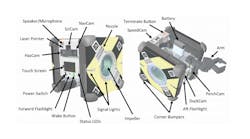e2v (Chelmsford, UK) has been awarded a contract by the European Space Agency (ESA) to develop a new CCD imaging sensor for the PLATO (PLAnetary Transits and Oscillations of Stars) space science mission. The aim of PLATO is to search for transiting planets within the Milky Way to understand the conditions for planet formation and the emergence of life.
PLATO aims to detect planets from their transits across their host star and to characterize their host stars by studying their oscillations. To achieve this aim the mission proposes to fly a satellite with a focal plane of up to 34 mini-telescopes, each containing four large area back-illuminated CCDs to provide ultra high precision photometry. If successful, the satellite will have nearly 0.9 sq m of image sensors and will be by far the largest image sensor focal plane ever flown.
The mission is in a competitive definition phase with two other ESA Cosmic Vision programmes: Solar Orbiter and Euclid, for which e2v has also won a development contract. The two successful missions will be selected in June 2011 and will be carried forward into implementation leading to a launch in 2018.
SOURCE: e2v
Posted by Vision Systems Design
Voice Your Opinion
Voice Your Opinion




